Chugging from a Human Heart: a Scandinavian Interlude.
Turns out I have too much to do, and too many images to share; so I’m going to stretch what was originally intended to be a two-parter into a trilogy. Call it the Jackson Maneuver.
There were lectures in Bergen. There was a con in Uppsala. But in between, there was a flight across the mountains and a day spent skulking through Scandinavian streets, thusly:
(As usual, click the pic to enbiggen)
 Fleeing Norway's repressive child-marriage laws, I escape across the mountains with my ten-year-old bride. |
 The Escape Pod  One of Uppsala's major downtown streets. The mayor of Toronto would regard the numerous bicycles as clear-cut evidence of socialism. |
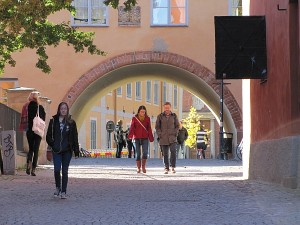 We were told by our guide that this surprisingly-sunny archway featured prominently in many Ingmar Bergman films. |
 I am willing to take his word for it. |
 The architects of this cathedral were not overcompensating for anything. |
 Linnaeus, the father of modern (precladistic) taxonomy, lies buried within. More on him later. |
 In fact the whole damn place was infested with these memorial slabs, and the interred corpses beneath. It was actually a wee bit creepy. |
 The 1% of bygone days could afford somewhat more luxurious accommodation. These 16th-century nobles obviously ripped off Peter Jackson's vision of Aragorn's crypt from Lord of the Rings... |
 ...although others opted for less-idealized memorials. |
 Not all of the Faithful could afford formal interment. This pilgrim was stuffed in 1763. |
 All that said, though, the architecture surrounding this high-end mass grave was nothing short of awe-inspiring. |
 I've said it before: can you imagine what could be accomplished if this kind of dedication was redirected to good instead of evil? |
 |
 |
 Leaving the Cathedral en route to the Academy -- halfway between Faith and Reason -- we encountered this runestone. After stroking it, I found myself 20% more successful at picking pockets. |
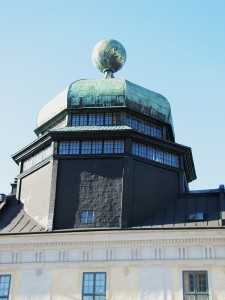 The Gustavianum is now a museum. It used to be the beating heart of Uppsala University... |
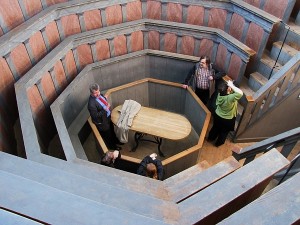 ...Or at least, it used to *contain* beating hearts on occasion. This is where they were removed. Snacks were available along the upper level. |
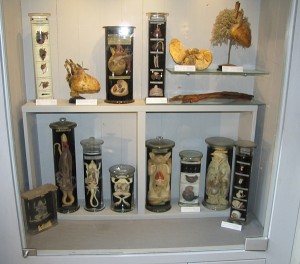 The gift shop. My stepdaughters don't know it yet, but they're going to have the best Christmas *evar*. |
 A primitive TARDIS from the 18th Century. When fully packed, every other display in the room fits into this box. |
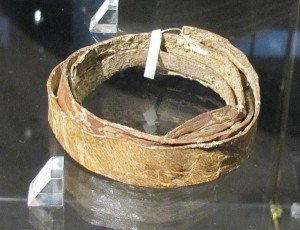 This is a strip of human skin approximately one meter long. (Sadly for the Pones on Christmas, it was not available in the gift shop.) |
 Guess what this is. Just guess. Give up? It is -- I shit you not -- a drinking flask whittled from an EMBALMED HUMAN HEART. The Swedes really know how to while away those long winter nights. Don't fuck with them. |
 Evidently the Swedes also have worse problems with head lice than most of us would consider normal. |
 Linnaeus sent his apprentices around the world in search of biological diversity. However, he evidently did not provide sufficient postage for the shipping of specimens in actual boxes. This fish was flattened between two iron plates and mailed to Uppsala in a manilla envelope. (I am told that they did the same thing with parrots, but the results were insufficiently tidy for public exhibition.) |
 Uppsallans are justly proud of their home-boy Linneaus; the streets are festooned with homage. This is a likeness of Carl in his younger days. |
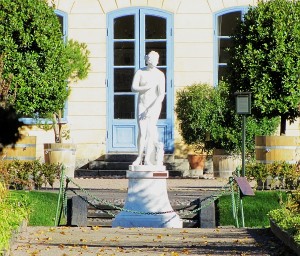 And this is his mom. |
 Here is the entrance to the museum dedicated to the celebration of his life (we heard rustling beyond, but no one would open the gate no matter how hard we kicked). |
 Even modern hotels are named for this giant of binomial nomenclature. The formal taxonomy of the species shown on the flag has never been definitively established. |
Such was the land. The con itself was slightly less grisly (with the possible exception of the sing-along Buffy marathon).
Stay tuned.
This entry was posted
on Friday, October 12th, 2012 at 10:51 am and is filed under
On the Road,
public interface.
You can follow any responses to this entry through the
RSS 2.0 feed.
Both comments and pings are currently closed.




































The Swedes may have their Giant Head Lice, but the Norwegians have unfortunately lent their name to Norwegian Scabies.
That website dedicated to this worrisome condition has a particularly depressing section on Norwegian Scabies in Homeless AIDS Patients.
Keep rubbing that runestone…
Mr Non-Entity,
Heh, never mind the ever lovely rattus norvegicus.
I don’t believe that that is really a statue of Mrs. Linnaeus.
I think that it was someone else’s mother.
Willi Hennig’s, perhaps.
That is not a head louse*, that is a crab.
rgl
*Yngvi
@ digi_owl: Someone really didn’t like the Norwegians, I guess.
It’s like naming something “mastigoproctus teianicus” or the Texas Whip-scorpion when actually they’re from all over “drylands” southern North America.
@ rgl: And right you are. But it certainly does look like a giant head louse. Don’t think I’d care to eat either one, thanks. 😉
Damnit, why can’t we have magic thief skill enhancing runestones? C’mon Sweden, share the love!
[…] http://munin.kallner.com/2012/10/12/hade-riktigt-kul-pa-kontrast-2012/ https://www.rifters.com/crawl/?p=3549 […]
Thanks for signing my copy of Blindsight at the Uppsala English Bookshop! Hope to see you around here again sometime.
Okay, I held out as long as I could. I have to ask: what do we need a meter-long strip of human leather for? Belt? Momento of a deceased loved one? A general momento mori?
One of the things I like about old churches is that they’re also graveyards. And the stuffed pilgrim–eee! I love her!
Palermo has a monastery filled with weird mummies.
Why the meter-long strip of human skin?
The cheapskates didn’t feel like paying for the entire stuffed pilgrim! 😉
Seriously, the Latins can be at least as morbid. At the Capuchin Catacombs in Rome, there is a sign placed before a huge pile of skeleta, reading “As you are now, so once were we. As we are now, some day you’ll be”. For real: miles and miles of dead people hanging on the wall like art. Very Seriously Goth As Fuck.
That’s so wonderful, to have the body of the person, dry and dead, of course, but there in their clothes, waiting quietly for you to visit them! Freaky, but nice.
When visiting a grave, I always picture the person’s body in the dark, in a metal vault, mouldering, and thinking, hm, wouldn’t it be better if they were directly in the dirt, gradually going back into the soil. I always found the idea of them liquifying in a dead air space kind of awful.
I understand there are services in the US now that will quick-freeze you, so you can be easily mulched and used to fertilize around the base of a tree. I wouldn’t mind being a mummy in a catacomb in Sicily, but becoming part of a tree sounds divine for some reason. I mean, we have been exhaling and inhaling out of and into each other all my life, why not become more directly part of a tree?
Well, there’s the Dakhma, the place of ritual exposure of the dead to the elements, as practiced by the Zoroastrians.
Also, in a variety of cultures, the idea of planting a tree seed or other seeds above the interred dead, very common. See also the closing lyrics of the classic song “Barbry Allen in the Ozark Mountain traditional version, where on the graves of the star-crossed lovers grow entwined rose and briar.
Noted in passing: my late mother spent a great deal of her time in the yard and garden over her lifetime, and she’ll be spending much of eternity there; it’s where I scattered her ashes. The flowers did quite well this last year, and the nut crop this fall is practically exorbitant. She well understood the notion of food chain while alive, and our changing roles in that order.
In SF, Rene Barjavel wrote the classic Ravage, translated into English as Ashes, Ashes. Published in French in 1943, it depicts a future society in which it is all the rage (and has been for years) to keep a room in the house which is kept refrigerated to preserve the earthly remains of the dear departed, who are of course artfully dressed and posed behind the window glass of these shrines. It becomes something of a cult as well as a fashion statement among social climbers, etc. Barjavel does a masterful job, if I recall correctly, of making this all completely believable by way of explaining how this first came to be, and then came to be the social standard. By the time of the story, limitless electricity and a low birth rate mean that the dead in their cryocrypts are almost as numerous as the living on the warm side of the windows. Barjavel gives us a few days or weeks in the life of a harried civil servant, endlessly pressured by his wife to enlarge their shrine so that when other elders pass, there will be room enough for them to be kept in the style which confers some additional respectability to the maintainers. Sadly, the power fails, and not only does the larder thaw, so do the deceased, and most of the novel is a pretty good “escape from the collapsing cities” story. Personally I prefer the notion of recycling the dead back to the ecosphere rather than going to any extremes for preservation. Plant acorns on the graves of carpenters, as it were, and farmers in their fields. And Happy Hallowe’en to all.
Having finally done an image search, that crab does look more like a pubic louse* than a head louse.
rgl *pubic louse==crabs(in Alberta slang)
If you think whip scorpions are cool, check out the tail-less whip scorpions. Why do they evoke such deep, animistic horror?
That bike stand is almost empty, the one at uppsala train station usually isn’t.
I really enjoyed your talks/panels at kontrast, most interesting at the con.